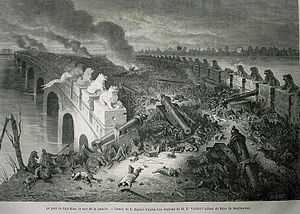Second Opium War
| ||||||||||||||||||||||||||||
The Second Opium War, the Second Anglo-Chinese War, the Second China War, the Arrow War, or the Anglo-French expedition to China,[1] was a war pitting the British Empire and the Second French Empire against the Qing dynasty of China, lasting from 1856 to 1860. It was fought over similar issues as the First Opium War.
Names
"Second War" and "Arrow War" are both used in literature. "Second Opium War" refers to one of the British tactical objectives: legalising the opium trade, expanding coolie trade, opening all of China to British merchants, and exempting foreign imports from internal transit duties. The "Arrow War" refers to the name of a vessel which became the starting point of the conflict. The importance of the opium factor in the war is in debate among historians.
First phase
Outbreak

The 1850s saw the rapid growth of European and American imperialism. Some of the shared goals of the western powers were the expansion of their overseas markets and the establishment of new ports of call. The French Treaty of Huangpu and the American Wangxia Treaty both contained clauses allowing renegotiation of the treaties after 12 years of being in effect. In an effort to expand their privileges in China, Britain demanded the Qing authorities renegotiate the Treaty of Nanking (signed in 1842), citing their most favoured nation status. The British demands included opening all of China to British merchant companies, legalising the opium trade, exempting foreign imports from internal transit duties, suppression of piracy, regulation of the coolie trade, permission for a British ambassador to reside in Beijing and for the English-language version of all treaties to take precedence over the Chinese language.
The Qing dynasty court rejected the demands from Britain and France, which would in turn lead to the start of the second Opium War.
With regard to the British demands and pressure, the Chinese authorities were reluctant to keep to the terms of the Treaty of Nanking. They had tried to keep out as many foreign merchants as possible and had victimized Chinese merchants who traded with the British at the treaty ports. To protect those Chinese merchants who were friendly to them in Hong Kong, the British granted their ships British registration in the hope that the Chinese authorities would not interfere with vessels carrying the British flag. In October 1856, Chinese authorities in Canton seized a vessel called the Arrow, which had been engaged in piracy. The Arrow had formerly been registered as a British ship and still flew the British flag. The British consul in Canton demanded the immediate release of the crew and an apology for the insult to the flag. Chinese authorities argued that the Arrow was a pirate ship and had no right to fly the British flag as its British registration had expired. This event came to be known as the Arrow Incident[2] and provided the alternative name of the ensuing conflict.
Once the crew of the Arrow had been released and with no apology forthcoming from the Chinese, the British governor of Hong Kong, without first consulting with his superiors in London, ordered warships to bombard Canton. The British Prime Minister, Palmerston, later supported the actions of his officials, who claimed to be upholding British prestige and avenging the insult to the flag. Moreover, Palmerston may have been seeking to force the Chinese into accepting full-scale trade with Britain.
Operations were commenced against the Barrier Forts on the Canton River. From 23 October to 13 November, these naval and military operations were continuous. The Barrier Forts, the Bogue Forts, the Blenheim Forts, and the Dutch Folly Forts, and twenty-three Chinese junks, were all taken or destroyed. The suburbs of Canton were pulled, burnt, or battered down, that the ships might fire upon the walls of the town.[3]
Faced with fighting the Taiping Rebellion, the Qing government was in no position to resist the West militarily.
British attacks
Although the British were delayed by the Indian Rebellion of 1857, they followed up the Arrow Incident in 1856 and attacked Guangzhou from the Pearl River. The governor of Guangdong and Guangxi provinces, Yeh Mingchen, ordered all Chinese soldiers manning the forts not to resist the British incursion. After taking the fort near Guangzhou with little effort, the British Army attacked Guangzhou.
Meanwhile, in Hong Kong, there was an attempt to poison the British Superintendent of Trade, Sir John Bowring and his family in January. However, the baker who had been charged with lacing bread with arsenic bungled the attempt by putting an excess of the poison into the dough. This meant that his victims threw up sufficient quantities of the poison as to only have a non-lethal dose left in their system. Criers were sent out with an alert, averting disaster.[4]
When known in Britain, the Arrow incident (and the British military response) became the subject of controversy. The British House of Commons on 3 March passed a resolution by 263 to 249 against the Government saying: That this House has heard with concern of the conflicts which have occurred between the British and Chinese authorities on the Canton River; and, without expressing an opinion as to the extent to which the Government of China may have afforded this country cause of complaint respecting the non-fulfilment of the Treaty of 1842, this House considers that the papers which have been laid on the table fail to establish satisfactory grounds for the violent measures resorted to at Canton in the late affair of the Arrow, and that a Select Committee be appointed to inquire into the state of our commercial relations with China.[5] In response, Lord Palmerston assaulted the patriotism of the Whigs who sponsored the resolution and Parliament was dissolved, causing the British general election of March 1857.
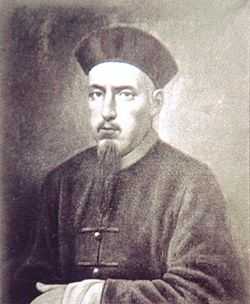
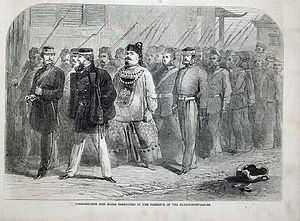
The Chinese issue figured prominently in the election, and Palmerston won with an increased majority, silencing the voices within the Whig faction who supported China. The new parliament decided to seek redress from China based on the report about the Arrow Incident submitted by Harry Parkes, British Consul to Guangzhou. The French Empire, the United States, and the Russian Empire received requests from Britain to form an alliance.
Intervention of France
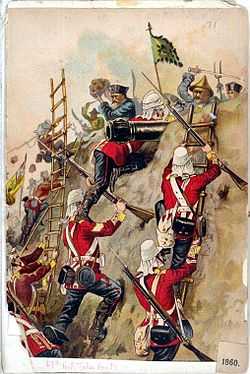
France joined the British action against China, prompted by complaints from their envoy, Baron Jean-Baptiste Louis Gros, over the execution of a French missionary, Father Auguste Chapdelaine,[6] by Chinese local authorities in Guangxi province, which at that time was not open to foreigners. [7]
The United States and Russia sent envoys to Hong Kong to offer help to the British and French, though in the end Russia sent no military aid, and the US fought only at the Pearl River Forts in 1856 and at the Taku Forts in 1859.
The British and the French joined forces under Admiral Sir Michael Seymour. The British army led by Lord Elgin, and the French army led by Gros, attacked and occupied Guangzhou in late 1857. Yeh Mingchen was captured, and Bogui, a Mongol who was governor of Guangdong, surrendered. A joint committee of the Alliance was formed. The Allies left Bogui at his original post in order to maintain order on behalf of the victors. The British-French Alliance maintained control of Guangzhou for nearly four years. Yeh Mingchen was exiled to Calcutta, India, where he starved himself to death.[8]
The coalition then cruised north to briefly capture the Taku Forts near Tientsin (now known as Tianjin) in May 1858.
Interlude
Treaties of Tientsin
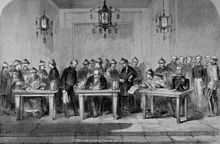
In June 1858, the first part of the war ended with the four Treaties of Tientsin, to which Britain, France, Russia, and the U.S. were parties. These treaties opened 11 more ports to Western trade. The Chinese initially refused to ratify the treaties.
The major points of the treaty were:
- Britain, France, Russia, and the U.S. would have the right to establish diplomatic legations (small embassies) in Peking (a closed city at the time)
- Ten more Chinese ports would be opened for foreign trade, including Niuzhuang, Tamsui, Hankou, and Nanjing
- The right of all foreign vessels including commercial ships to navigate freely on the Yangtze River
- The right of foreigners to travel in the internal regions of China, which had been formerly banned
- China was to pay an indemnity of four million taels of silver to Britain and two million to France.[9]
Treaty of Aigun
On 28 May 1858, the separate Treaty of Aigun was signed with Russia to revise the Chinese and Russian border as determined by the Nerchinsk Treaty in 1689. Russia gained the left bank of the Amur River, pushing the border south from the Stanovoy mountains. A later treaty, the Convention of Peking in 1860, gave Russia control over a non-freezing area on the Pacific coast, where Russia founded the city of Vladivostok in 1860.
Second phase
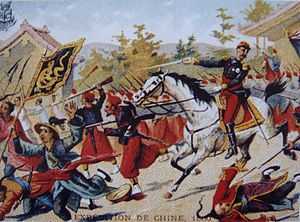



Anglo-French invasion
In June 1858, shortly after the Qing Court agreed to the disadvantageous treaties, more hawkish ministers prevailed upon the Xianfeng Emperor to resist encroachment by the West. On 2 June 1858, the Xianfeng Emperor ordered the Mongolian general Sengge Rinchen to guard the Dagu Forts near Tianjin. Sengge Richen reinforced the forts with added artillery. He also brought 4,000 Mongolian cavalry from Chahar and Suiyuan.
In June 1859, a British naval force with 2,200 troops and 21 ships, under the command of Admiral Sir James Hope, sailed north from Shanghai to Tianjin with newly appointed Anglo-French envoys for the embassies in Beijing. They sailed to the mouth of the Hai River guarded by the Dagu Forts near Tianjin and demanded to continue inland to Beijing. Sengge Rinchen replied that the Anglo-French envoys may land up the coast at Beitang and proceed to Beijing but refused to allow armed troops to accompany them to the Chinese capital. The Anglo-French forces insisted on landing at Dagu instead of Beitang and escorting the trip to Beijing. On the night of 24 June 1859, a small batch of British forces blew up the iron obstacles that the Chinese had placed in the Baihe River. The next day, the British forces sought to forcibly sail into the river, and shelled the Taku Forts. Low tide and soft mud prevented their landing, however, and accurate fire from Sengge Rinchen's canons sank four gunboats and severely damaged two others. American Commodore Josiah Tattnall, although under orders to maintain neutrality, declared "blood is thicker than water," and provided covering fire to protect the convoy's retreat. The failure to take Dagu was a blow to British prestige, and anti-foreign resistance reached a crescendo within the Qing Court. [10]
In the summer of 1860, London once more dispatched Lord Elgin with an Anglo-French force of 11,000 British under General James Hope Grant, 6,700 French under General Cousin-Montauban. They pushed north with 173 ships from Hong Kong and captured the port cities of Yantai and Dalian to seal the Bohai Gulf. On 3 August they carried out a landing near at Beitang (also spelled "Pei Tang"), some 3 kilometres (1.9 mi) from the Taku Forts, which they captured after three weeks on 21 August. After taking Tianjin on 23 August, the Anglo-French forces marched inland toward Beijing. The Xianfeng Emperor then dispatched ministers for peace talks, but the British diplomatic envoy, Harry Parkes, insulted the imperial emissary and word arrived that the British had kidnapped the prefect of Tianjin. Parkes was arrested in retaliation on 18 September. Parkes and his entourage were imprisoned and interrogated. Half were reportedly executed by slow slicing, with the application of tourniquets to severed limbs to prolong the torture; this infuriated British leadership when they recovered the unrecognizable bodies. The Anglo-French forces clashed with Sengge Rinchen's Mongolian cavalry on 18 September near Zhangjiawan before proceeding toward the outskirts of Beijing for a decisive battle in Tongzhou District, Beijing. [11]
On 21 September, at the Balichiao (Eight Mile Bridge), Sengge Rinchen's 10,000 troops including elite Mongolian cavalry were annihilated after doomed frontal charges against concentrated firepower of the Anglo-French forces, which entered Beijing on 6 October.
United States Conflicts during the War
The U.S. was involved in two conflicts the first in retaliation for a Chinese attack on a U.S. Navy officer. The resulting campaign was the Battle of the Pearl River Forts, near Canton. The second was in 1859 when a U.S. warship, the USS San Jacinto bombarded the Dagu Forts in support of British and French troops on the ground.[12]
Burning of the Summer Palaces
With the Qing army devastated, Emperor Xianfeng fled the capital leaving Prince Gong in charge of negotiations. Xianfeng first fled to the Chengde Summer Palace and then to Rehe Province.[13] Anglo-French troops in Beijing began looting the Summer Palace (Yihe Yuan) and Old Summer Palace (Yuan Ming Yuan) immediately (as it was full of valuable artwork). After Parkes and the surviving diplomatic prisoners were freed, Lord Elgin ordered the Summer Palaces destroyed starting on 18 October. Beijing was not occupied; the Anglo-French army remained outside the city.
The destruction of the Forbidden City was discussed, as proposed by Lord Elgin to discourage the Chinese from using kidnapping as a bargaining tool, and to exact revenge on the mistreatment of their prisoners.[14] Elgin's decision was further motivated by the torture and murder of almost twenty Western prisoners, including two British envoys and a journalist for The Times.[15] The Russian envoy Count Ignatiev and the French diplomat Baron Gros settled on the burning of the Summer Palaces instead, since it was "least objectionable" and would not jeopardise the treaty signing.[14]
Aftermath


After the Xianfeng emperor and his entourage fled Beijing, the June 1858 Treaty of Tianjin was finally ratified by the emperor's brother, Yixin, the Prince Gong, in the Convention of Peking on 18 October 1860, bringing The Second Opium War to an end.
The British, French and—thanks to the schemes of Ignatiev—the Russians were all granted a permanent diplomatic presence in Beijing (something the Qing resisted to the very end as it suggested equality between China and the European powers). The Chinese had to pay 8 million taels to Britain and France. Britain acquired Kowloon (next to Hong Kong). The opium trade was legalised and Christians were granted full civil rights, including the right to own property, and the right to evangelise.
The content of the Convention of Peking included:
- China's signing of the Treaty of Tianjin
- Opening Tianjin as a trade port
- Cede No.1 District of Kowloon (south of present day Boundary Street) to Britain
- Freedom of religion established in China
- British ships were allowed to carry indentured Chinese to the Americas
- Indemnity to Britain and France increasing to 8 million taels of silver apiece
- Legalisation of the opium trade
Two weeks later, Ignatiev forced the Qing government to sign a "Supplementary Treaty of Peking" which ceded the Maritime Provinces east of the Ussuri River (forming part of Outer Manchuria) to the Russians who went on to found the port of Vladivostok between 1860–61. The Anglo-French victory was heralded in the British press as a triumph for British Prime Minister Lord Palmerston, which made his popularity rise to new heights. British merchants were delighted at the prospects of the expansion of trade in the Far East. Other foreign powers were pleased with the outcome too, since they hoped to take advantage of the opening-up of China.
The defeat of the Imperial army by a relatively small Anglo-French military force (outnumbered at least 10 to 1 by the Qing army) coupled with the flight (and subsequent death) of the Emperor and the burning of the Summer Palace was a shocking blow to the once powerful Qing Dynasty. "Beyond a doubt, by 1860 the ancient civilisation that was China had been thoroughly defeated and humiliated by the West."[16] After the war, a major modernisation movement, known as the Self-Strengthening Movement, began in China in the 1860s and several institutional reforms were initiated.
See also
| Wikisource has original text related to this article: |
- First Opium War
- Unequal treaties
- Anglo-Chinese relations
- Imperialism in Asia
- Taiping Rebellion
- Nian Rebellion
- Miao Rebellion (1854–73)
- Dungan revolt (1862–1877)
- Panthay Rebellion
- History of Beijing
References
- ↑ Michel Vié, Histoire du Japon des origines a Meiji, PUF, p.99. ISBN 2-13-052893-7
- ↑ Tsai, Jung-fang. [1995] (1995). Hong Kong in Chinese History: community and social unrest in the British Colony, 1842–1913. ISBN 0-231-07933-8
- ↑ Richard Cobden's speech to parliament http://en.wikisource.org/wiki/China_and_the_Attack_on_Canton
- ↑ John Thomson 1837–1921, Chap on Hong Kong, Illustrations of China and Its People (London,1873–1874)
- ↑ http://www.econlib.org/library/YPDBooks/Cobden/cbdSPP39.html
- ↑ David, Saul (2007). Victoria's Wars: The Rise of Empire. London: Penguin Books. pp. 360–361. ISBN 978-0-14-100555-3.
- ↑ Hsü 2000, p. 206.
- ↑ Hsü 2000, p. 207.
- ↑ Ye Shen, Shirley; Shaw, Eric H. "The Evil Trade that Opened China to the West" (PDF). p. 197. Retrieved 21 September 2014.
- ↑ Hsü 2000, p. 212-213.
- ↑ Hsü 2000, p. 214-215.
- ↑ Hsü 2000, p. 205-208.
- ↑ Hsü 2000, p. 215.
- ↑ 14.0 14.1 Endacott, G. B.; Carroll, John M. (2005) [1962]. A biographical sketch-book of early Hong Kong. Hong Kong University Press. ISBN 978-962-209-742-1.
- ↑ Hsü 2000.
- ↑ Hsü 2000, p. 219.
- Bibliography
- Hsü, Immanuel C. Y. (2000). The Rise of Modern China. New York: Oxford University Press. ISBN 978-0-19-512504-7.
Further reading
- Bickers, Robert A. (2011). The scramble for China: foreign devils in the Qing empire, 1800-1914. London: Allen Lane. ISBN 9780713997491.
- Beeching, Jack. The Chinese Opium Wars (1975), ISBN 0-15-617094-9
- W. Travis Hanes III and Frank Sanello, The Opium Wars, 2002, ISBN 0-7607-7638-5
- Hevia, James Louis (2003). English lessons: the pedagogy of imperialism in nineteenth-century China. Durham; Hong Kong: Duke University Press; Hong Kong University Press. ISBN 0822331519.
- Henry Loch, Personal narrative of occurrences during Lord Elgin's second embassy to China 1860, 1869.
- Lovell, Julia (2011). Opium War. London: Picador. ISBN 9780330537858.
- Ringmar, Erik (2013). Liberal Barbarism: The European Destruction of the Palace of the Emperor of China (PDF). New York: Palgrave Macmillan.
- Spence, Jonathan D. (2013). The search for modern China. New York: Norton. ISBN 9780393934519.
- Wong, J. Y. (1998). Deadly dreams: opium, imperialism, and the Arrow War (1856-1860) in China. Cambridge; New York: Cambridge University Press. ISBN 0521552559.
- Wong, J. Y. "Harry Parkes and the 'Arrow War' in China," Modern Asian Studies (1975) 9#3 pp 303–320.
External links
| Wikimedia Commons has media related to Second Opium War. |
| ||||||||||||||||||
| ||||||||||||||||||
| ||||||||||||||||||
